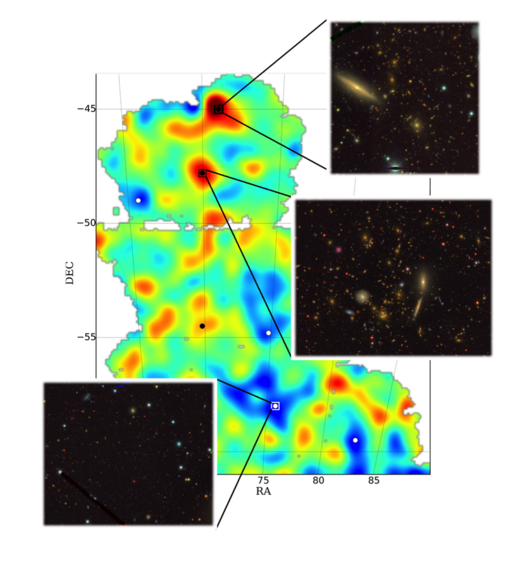Scientists from the Dark Energy Survey (DES) collaboration announced a new and precise map of the distribution of dark matter at the annual meeting of the American Physical Society. Using a very sophisticated camera containing 570 million pixels, scientists imaged distant galaxies, looking for tiny distortions in the galaxies' shapes. This distortion is caused by a phenomenon called gravitational lensing.
Gravitational lensing is a prediction of Einstein's theory of general relativity and was confirmed in 1919. In essence, gravitational lensing is caused when the presence of mass bends space and thereby alters the path of a beam of light. In this manner, a distant object can have its shape distorted by the existence of mass.
By looking at small distortions of galaxies at a range of distances from Earth, scientists were able to work out the distribution of mass between those galaxies and us. Astronomers then compare the amount of mass needed to cause the observed distortions with the amount of mass seen in galaxies and gas in the foreground. The remainder is inferred to be caused by dark matter.
Dark matter is a hypothesized form of matter that is five times more common than the ordinary matter of atoms. It has been invoked to solve mysteries of why galaxies rotate more quickly than expected and why clusters of galaxies are held together.
The technique used by the DES collaboration is analogous to looking at distance galaxies through a lens. By studying the small distortions, one could work out the nature of the lens. In this instance, the lens isn't glass, but rather the intervening mass.
The recently announced result uses only 3.3 percent of the sky being surveyed by the DES telescope and a small amount of the data. DES will take data over a five year period and, with more data, they will be able to vastly expand their study, both across the sky and in terms of possibly segmenting their study in terms of the distance from Earth.
In this way, it will eventually be possible to make a three dimensional map of the dark matter distribution of the universe. The measurement thus far is a strong confirmation of the theory of dark matter and scientists are very interested in seeing if the more precise measurements in the future will tell a similar tale.
For more details, the technical paper is available here.
